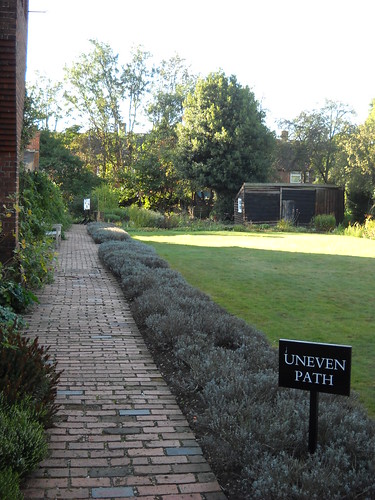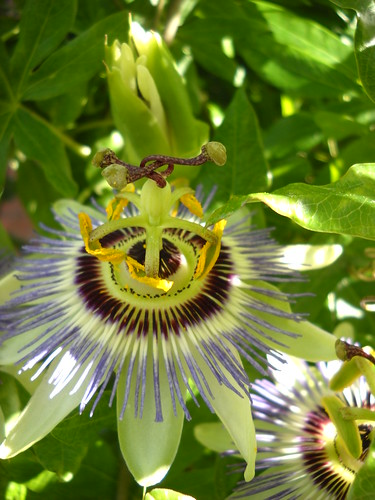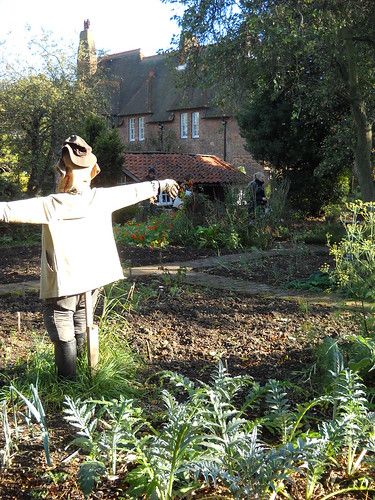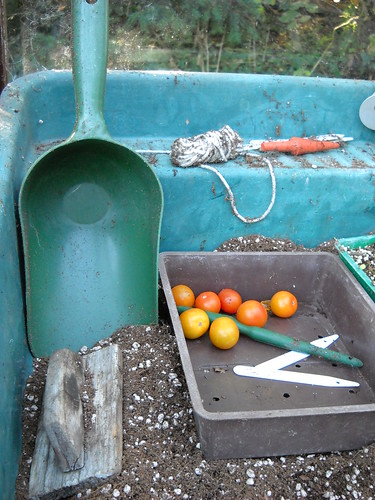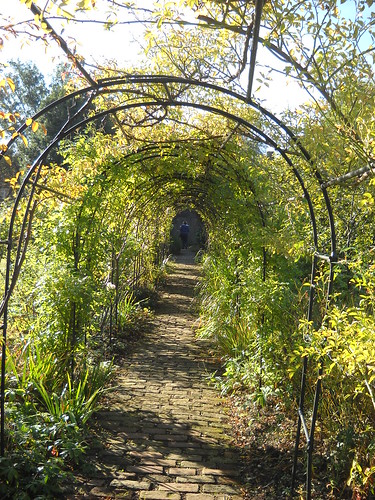 |
| Stanley Spencer (1891 – 1959) Turkeys, 1946 |
23 November 2011
17 November 2011
William Morris's Earthly Paradise
I just remembered that I forgot to write about the garden of The Red House after posting about the house itself! Oops! Guess I got carried away with all the art in the Middle Ages and the sparkly gilding and flashing water of Louis XIV's court (I'm still hung up on his shoes - I can't even wear heels like that!).
Since we've just flown through the Victorian mixed style garden in our lessons and are fast approaching the Arts and Crafts movement, now seems a good time to correct that mistake. Herewith I present to you William Morris's garden:
We arrived at The Red House on a chilly morning just as the sun was beating through the morning mist, and as we gathered in the new orchard to discuss some lessons and the day's plan I noticed pockets of long grass with shorter paths mowed between the trees in a meandering fashion. Several bee hives were tucked in the corner by the wall and a bench offered a nice spot in the sun to rest. It was a very romantic spot in the garden at that time of day, and you almost forgot your were in the middle of suburbia with all the birdsong around.
One part of the garden that intrigued me was this clearing as you walk to the tea shop (part of the old stables).
Since we've just flown through the Victorian mixed style garden in our lessons and are fast approaching the Arts and Crafts movement, now seems a good time to correct that mistake. Herewith I present to you William Morris's garden:
There are actually two layers to the garden as you see it now: the garden as it was in the time of Morris, and after it was expanded by subsequent owners. The plan above shows what the garden probably looked like when Morris lived here. The entire property was bounded by a red brick wall - most of which remains and the short spur you can see in the upper right of the drawing is still there to mark the original boundary. The paths around the house at this time were likely gravel or tamped soil, not the brick that's there now, and my classmates and I theorized on the probability that the paths were laid with bricks from the old wall when it was pulled down. Kudos to them for recycling!
The path around the house is bordered by a lavender hedge with a rectangular lawn where the family no doubt played croquet. Against the house are espaliered pear and apple trees, most original but some have been lost over the years. I was also intrigued by the three square planting beds in the brick containing Passiflora on metal supports. The vines undoubtedly received heat radiating from the wall, because I couldn't find any other explanation for a passion vine to be blooming so frivolously in the middle of a chilly autumn morning in England! When I was growing up our back fence was covered with passion vine, which was the host food for Gulf Fritillary butterflies (Agraulis vanillae), and the fence was covered with chrysalis (chrysali?) each fall followed by the delightful silver and orange cat's eyes flitting about, so I have a soft spot for this plant!
The Morris garden had a small orchard and from I was told, the surrounding area at the time would have been very rural with agricultural fields and orchards so he incorporated part of an existing orchard into the garden when the house was built. (There are traces of that in So Cal, where citrus orchards once stretched into the horizon. When the houses went up, each back yard usually contained one or two of the trees that were left after the bulldozer had its way).
 |
| Click to embiggen |
This plan shows the garden after expansion to include a veg garden (I want it!), more orchard space, a wilderness or shrubbery walk around the perimeter with tall trees planted as the suburbs came to keep prying eyes out, and planting beds on the east side of the house.
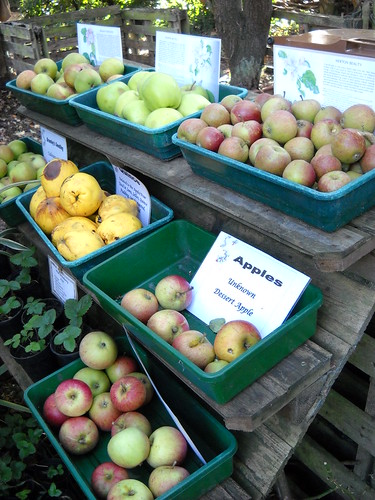 |
| Apples picked from the orchard are offered for sale to visitors |
One part of the garden that intrigued me was this clearing as you walk to the tea shop (part of the old stables).
Mr. Morris was into Medievalism in a big way, and from my reading I learned that to Medieval man, when all around was chaos and danger (hence the castle walls and enclosed gardens), a forest clearing was seen as a refuge in the dark and creepy wilderness, much as an oasis was for the desert nomad. The opening in the leafy canopy gave a view to the sky and an invisible line linking heaven and earth. It made me wonder, then, if this had been old Will's intention when he built the garden? The clearing wasn't on the 1862 plan, and as far as I could gather, is now in the place were the small enclosure is to the north of the house near the stable building used to be. Things that make me go, "Hmmmmmmm..."
Another thing that made me go, "Hmmm" was this addition to the back of the kitchen yard, clearly not in keeping with the style of the house. Remember that this area was once rural, before all the houses crept in, and the Red House was used in WW2 for refugees from the Blitz. The additions here are air raid shelters. Fat lot of good they'd do under a direct hit, seeing as Bexleyheath is square inside Bomb Alley, but here they are. There was talk of tearing them down and restoring this part of the garden but given that such structures are rarely seen and are in themselves historical artifacts, the National Trust has decided to keep them, a decision of which I approve. They don't detract from the garden, I feel, and lend an air of mystery and history to the fabric of the house. In fact, they provide yet another surface to decorate:
The Red House was acquired by the National Trust in 1999 and we all agreed that the garden didn't "feel" like a NT garden, for whatever that's worth. This one retained its character and charm and one could easily understand why Morris fancied calling it the 'Pilgrim's Rest' when he learned that an old Roman road passed nearby.
Next week in class we'll be studying the Arts and Crafts garden in more detail, so my visit to Great Dixter's Christmas fair next weekend is perfectly timed. Have I mentioned I love my work!?
Labels:
Arts and Crafts,
The Red House,
William Morris
13 November 2011
What a Garden Historian Does
When someone asks what I'm studying and I tell them, the usual response is for them to repeat the subject in a tone of some surprise sprinkled with doubt. Sometimes they emphasize the word 'garden' as in "Garden history?" indicating a grasp of the word 'history' and a decided uncertainty as to whether or not gardens have any. They do, indeed, I say, which is then followed by the inevitable question, "What does a garden historian do?"
Just one tiny part of what we do is study how and why a garden changed from this...
to this....
to this....
to this....
to this...
At least it's one tiny piece of what I'll be doing next year as part of my coursework. Exciting, hey!? Right now I have to get back to writing that word and image study on the English Landscape Movement...after all, given that history begins with the last moment, a garden historian's work is never at an end*.
*I held John Evelyn's Kalendarium Hortense, or Gardiner's Almanack, printed in 1664 from which this quote is taken, in my own hands last week. My friend Scott Daigre said it best: Kid. Candystore.
Just one tiny part of what we do is study how and why a garden changed from this...
 |
| Her Majesty's Royal Palace at Kensington, from 'Survey of London' engraved by Johannes Kip (c.1652-1722), 1730 (watercolor tinting is modern) |
 |
| Charles Bridgeman's plan, circa 1733 |
 |
| Plan of Kensington Gardens and Kensington Town drawn by John Rocque, 1756 |
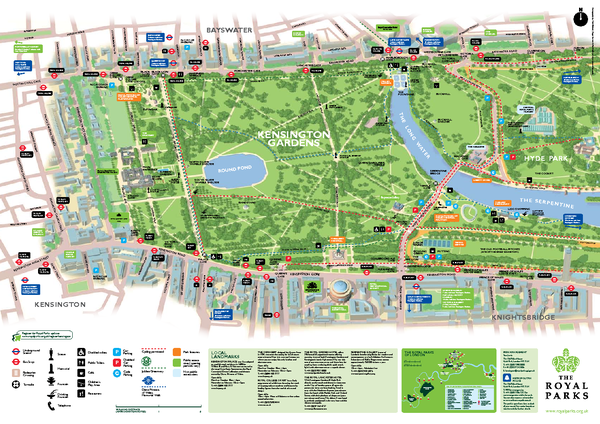 |
| Current map of the gardens and park |
 |
| Design by Todd Longstaffe-Gowan, 2011 |
At least it's one tiny piece of what I'll be doing next year as part of my coursework. Exciting, hey!? Right now I have to get back to writing that word and image study on the English Landscape Movement...after all, given that history begins with the last moment, a garden historian's work is never at an end*.
*I held John Evelyn's Kalendarium Hortense, or Gardiner's Almanack, printed in 1664 from which this quote is taken, in my own hands last week. My friend Scott Daigre said it best: Kid. Candystore.
10 November 2011
If It Ain't Baroque....
I know, that one's as old as dirt, which is probably why the style of garden design during the Baroque era is more commonly referred to as French Formal Style (particularly by those in France!). It is, in fact, a style of garden design that originated in France and came to a glorious apogee during the reign of the Sun King, Louis the Fourteenth (or XIV for those of you who prefer Roman numerals). One thing's for sure, the man's taste in fashion was outrageous !
Actually, the madness all started back in 1661 in a little chateau on the outskirts of Paris owned by an unfortunate man named Nicolas Fouquet. I say unfortunate because he was essentially a tax collector and we all know how popular they are, and also because he made one huge, foolish mistake (though his intentions were good).
Nicolas used his wealth to build a rather lavish home, and he hired the Three Musketeers of the design world to do it. Architect LeVau, painter LeBrun, and gardener LeNotre all conspired together to build what was then the most magnificent, most opulent, most exuberant, ostentatious, sumptuous, posh, recherché, très scandaleux, etcetera estate that a French noble ever clapped eyes on. It took almost 20 years from start to finish and by the time it was done, Fouquet was rightfully pleased and did what any house-proud member of the King's court would do: he threw a house-warming party! (oops!)
Back then it wasn't uncommon for a member of the nobility to dedicate a special room or wing of the house to the monarchy in the hopes that the royal chambers would be graced by the sovereign's presence. Fouquet was no different, and part of his little chateau at Vaux-le-Vicomte was indeed intended for the King.
Well! You can imagine old Louis' response. After all, he was the King - Le Roi Soleil! - the center of the French universe around whom all else orbited, and all he had to show for his polestar position was a swampy old hunting lodge that his dad left him. So he did what any outraged, absolutist Sun King with stellar footwear would do: he had poor Fouquet arrested on trumped up charges and thrown in jail for the rest of his life, then took the design team and most of the interior and exterior decorations and ordered them to do it up one better at Versailles.
And thus the Baroque/French Formal Style/Louis XIV style of garden design was born. But Louis didn't stop there. He had a message to put across (as if parading all that wealth and grandeur around in the form of an amazing palace and seemingly infinite garden weren't enough). This is where I could bore you with all the elements of the Baroque style and discourse endlessly about axial symmetry, parterres de broderie, bosquets, fountains, canals, theatres, topiary, clipped hedges, and plants forced into corsets, all going to show the extent of Louis's power and control over nature, but, with your indulgence, I'd much rather talk about the frogs.
They're much more than a French delicacy (though I wasn't brave enough to try them when I was in country). I mentioned the water-spouting amphibians in my last post and alluded to the fact that they weren't just decorative. A kind reader with an enquiring mind asked what they were all about. I will tell you, mon ami!
One of the things that was en vogue in garden design of this time was the use of classical motifs in the form of statuary and ornament, a trend surviving from Italian Renaissance gardens. Louis had them all over his garden, from the Apollo fountain (Apollo was the Roman sun god) to the Latona Fountain, which represents an episode from Ovid's Metamorphosis. In that tale, Latona, the mother of Apollo and Diana, suffered indignities from the peasants at Lycia. She was so outraged that she turned them all into frogs. King Louis' mom, likewise, suffered the disrespect of the people and the fountain was his response. Basically, it's saying "Don't mess with this Apollo or bad things will happen to you". Fouquet's arrest and disgrace would have been clear in every one's memory, and Louis wasn't one to shy away from exercising his divine right as King and Absolute Monarch when it came to (mis)interpretations of the law. He was the law, and if you crossed him, you were in for it.
Thanks to the Renaissance's revival of classic literature and mythology, people would have understood this allusion pretty clearly. Sadly, I think, much of that understanding has been lost. But now you, mon cher, know the fountain's secrets and can go out into the world and dazzle them with your je ne sais quoi!
And that, mon loutre, is the significance behind the frogs. Which made me wonder, when I saw the same motif on the fountain in the Italian Water Garden at Longwood, who Mr. DuPont had a beef with, or was he just enjoying the joke?
That, mon petit chou, is for you to ponder. And with that, I bid you adieu!
 |
| Louis XIV, the Sun King |
Nicolas used his wealth to build a rather lavish home, and he hired the Three Musketeers of the design world to do it. Architect LeVau, painter LeBrun, and gardener LeNotre all conspired together to build what was then the most magnificent, most opulent, most exuberant, ostentatious, sumptuous, posh, recherché, très scandaleux, etcetera estate that a French noble ever clapped eyes on. It took almost 20 years from start to finish and by the time it was done, Fouquet was rightfully pleased and did what any house-proud member of the King's court would do: he threw a house-warming party! (oops!)
 |
| Vaux-le-Vicomte |
Well! You can imagine old Louis' response. After all, he was the King - Le Roi Soleil! - the center of the French universe around whom all else orbited, and all he had to show for his polestar position was a swampy old hunting lodge that his dad left him. So he did what any outraged, absolutist Sun King with stellar footwear would do: he had poor Fouquet arrested on trumped up charges and thrown in jail for the rest of his life, then took the design team and most of the interior and exterior decorations and ordered them to do it up one better at Versailles.
 |
| Versailles circa 1701 |
 |
| Closeup of the Latona Fountain, frogs and all |
One of the things that was en vogue in garden design of this time was the use of classical motifs in the form of statuary and ornament, a trend surviving from Italian Renaissance gardens. Louis had them all over his garden, from the Apollo fountain (Apollo was the Roman sun god) to the Latona Fountain, which represents an episode from Ovid's Metamorphosis. In that tale, Latona, the mother of Apollo and Diana, suffered indignities from the peasants at Lycia. She was so outraged that she turned them all into frogs. King Louis' mom, likewise, suffered the disrespect of the people and the fountain was his response. Basically, it's saying "Don't mess with this Apollo or bad things will happen to you". Fouquet's arrest and disgrace would have been clear in every one's memory, and Louis wasn't one to shy away from exercising his divine right as King and Absolute Monarch when it came to (mis)interpretations of the law. He was the law, and if you crossed him, you were in for it.
Thanks to the Renaissance's revival of classic literature and mythology, people would have understood this allusion pretty clearly. Sadly, I think, much of that understanding has been lost. But now you, mon cher, know the fountain's secrets and can go out into the world and dazzle them with your je ne sais quoi!
And that, mon loutre, is the significance behind the frogs. Which made me wonder, when I saw the same motif on the fountain in the Italian Water Garden at Longwood, who Mr. DuPont had a beef with, or was he just enjoying the joke?
That, mon petit chou, is for you to ponder. And with that, I bid you adieu!
 |
| Ribbit! |
Subscribe to:
Posts (Atom)

